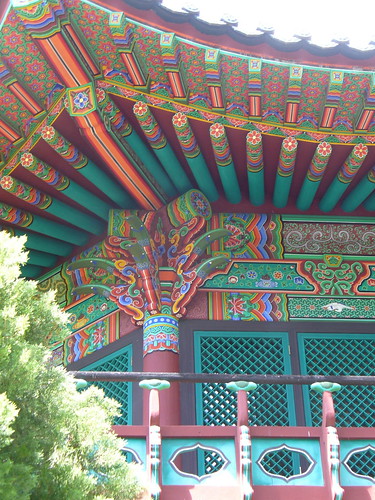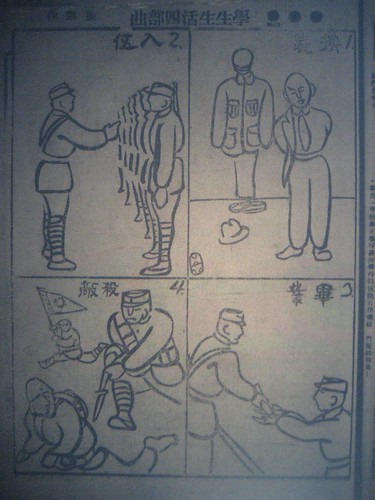There was a time in Korean labour movement history in the 1970s when it were the female workers who actually led the most militant part of the struggle. The reasons were obvious – while the wages were held generally low and grew on much lower rate than the economy as the whole (in the 1960s, the growth rate for economy were whopping 10%, but for real, inflation-adjusted wages in the manufacturing – modest 2,4% on the annualised basis), the female wages were always lower than the male ones, and military-like systemized bullying on the part of the male supervisors used to make factory life a miserable, constantly humiliating experience. Accordingly, some of the most moving struggles of the 1970s took place on the female-dominated textile factories – KyOngsOng Pangjik (1973) and Tongil Panjik (1978) strikes being the best known ones. In the latter case, the striking female workers were eventually assaulted by their male colleagues (?), beaten and showered with human excrements. Their response? On the Easter, 1978, they came to the public worship place on YOUido Square and succeeded in taking microphone for 5 minutes and shouting to the city and world – “우리는 똥을 먹고 살 수 없다!”. Of course, more beatings and arrest followed immediately, but the phrase ended becoming a tale-telling slogan of the female labour movement.
Now, I feel sometimes that the 1970s are returning, in a way. After 1997 crisis, females were first to be sacrificed on the altar of Washington consensus and “national interests” – put on contract (many of the contracts for tellers at the large malls, for example, are for 3 months or even 1 month), send to work on much worse conditions for a subcontractors, to which large part of the tasks was now “farmed out”, “re-employed” by some shadowy intermediary with proporationate part of the salary being withheld “for introduction”, and “flexibilized” in a million other methods, too diverse and creative to describe here. Now, 70% of Korea’s female workforce is “contingent” and “flexible”, on short-term contracts, subcontracted or supplied by “manpower agencies” – a world record of sorts. The women fought back, and the most protracted and bitter of all the struggles witnessed so far by the 2000s is the marathon strike by KTX (express train) female attendants – now well over 500 days and showing so far no signes of coming to an end. Below is the text of the appeal for their sake, prepared in its English form by a group of Korean female professors and sent to me by Prof. Na YungyOng (Culture Studies, Yonsei University):
“URGENT APPEAL for INTERNATIONAL SOLIDARITY
On March 1, 2006, approximately four hundred women who work as train attendants (similar to flight attendants) on the KTX “bullet train” began a strike to demand the end of discriminatory and unjust outsourcing practices of the Korea Railroad Corporation (KORAIL). Despite KORAIL’s promise that workers hired under short-term contracts via an external company would be granted permanent status as direct employees of KORAIL after one year, the KTX Crew Workers Branch Union’s demands for direct and permanent employment have yet to be met.
To date, the KTX Crew Workers’ Branch Union’s struggle is the longest and most bitterly waged fight by women workers in the history of Korea. For over 500 days, women who work as train attendants on the KTX bullet trains have held public rallies and marches, occupied buildings, lectured in classrooms, and conducted outreach on the streets and at train stations throughout the country. KORAIL’s continued refusal to meet the union’s demands for gender equality, safe working conditions and secure employment have led union leaders to engage in desperate measures to expose the unjust and unequal conditions under which they are forced to work. After exhausting every tactic, 31 union members began a hunger strike on July 2, 2007. As the hunger strike surpasses its 14th day, many union members have been rushed to the hospital..
Despite KTX’s sleek and high-tech image as the fifth fastest “bullet train” in the world, it is the site of blatant sexism and labor abuse. Of those train attendants who are irregularly employed under outsourcing agreements, the majority are women. In contrast, their male counterparts who perform comparable duties are directly employed by KORAIL as “team leaders.” Simply by being women, KTX train attendants are subject to lower wages, harsher working conditions, and heightened job insecurity. In addition, women workers face the perpetual threat of dismissal if they speak out against unfair conditions and sexual harassment in the workplace.
According to the National Human Rights Commission of Korea, KORAIL’s treatment of KTX female train attendants is a clear example of gender discrimination and a basic violation of human rights. The National Human Rights Commission has strongly recommended that striking KTX women workers be granted fair and just conditions of employment. The South Korean Minister of Labor, the legal community, various media outlets, 500 university professors, 300 members of the literary community and a wide cross section of NGOs including the Korea Women’s Association United, Lawyers for Democratic Society, People’s Solidarity for Participatory Democracy, Korea Women Workers Association United, and the People’s Coalition for Media Reform have also called upon KORAIL to reinstate the striking workers as directly hired employees, not as contingent workers contracted through a third party. However, KORAIL continues to disregard this overwhelming public outcry.
KORAIL, the nation’s largest public enterprise and employer of over 30,000 people, refuses to abide by the most basic and fundamental standards of fairness and equality. KORAIL’s actions violate South Korean laws that prohibit all forms of discrimination, as well as international standards established by the ILO to protect the rights of workers. KORAIL is also failing to comply with the international standards that the company itself pledged to uphold when it joined the UN Global Compact in May 2007.
KORAIL’s blatant violation of the basic principles of democracy and human rights deserve international criticism. KORAIL’s actions are indicative not only of the pervasive inequality facing contingent workers in South Korea, but also of systemic gender discrimination in South Korea. We urge the international community to stand in solidarity with the KTX Crew Workers in its brave fight for justice. We respectfully request your signature on this petition letter in support of the KTX women workers. This letter will be sent to President Roh Moo-hyun and UN Secretariat General Ban Ki-moon, as well as to the CEO of KORAIL.”
The letter of the appeal is enclosed below. Dear friends, if you think that the cause of the KTX workers is worthy, I beg you to sign it and return with you sign to ktxworkers@gmail.com (please, indicate your position and affiliation). More info in Korean is available at: http://ktxworkers.blogsome.com. This thing is URGENT, since only the Almighty knows how long the hunger strikers will be physically able to hold on.



